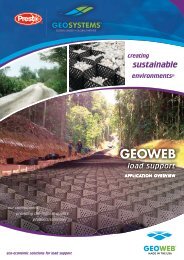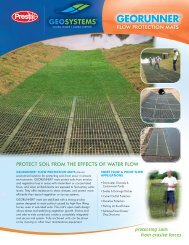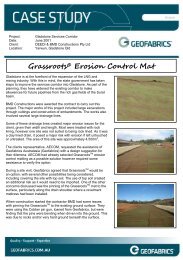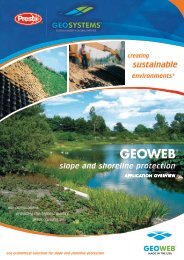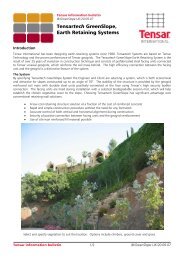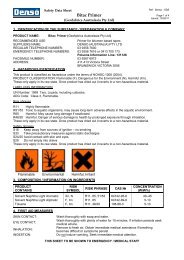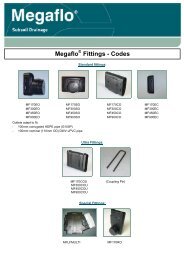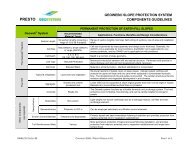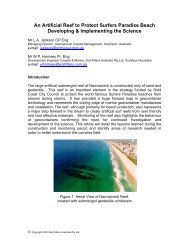Geotextile Reinforced Seals Under Asphalt - Geofabrics Australasia
Geotextile Reinforced Seals Under Asphalt - Geofabrics Australasia
Geotextile Reinforced Seals Under Asphalt - Geofabrics Australasia
You also want an ePaper? Increase the reach of your titles
YUMPU automatically turns print PDFs into web optimized ePapers that Google loves.
GEOTEXTILE REINFORCED SEALS UNDER ASPHALT<br />
Rod Fyfe, <strong>Geofabrics</strong> <strong>Australasia</strong>, South Australia<br />
ABSTRACT<br />
Paving fabrics are incorporated in asphalt paving act as a strain alleviating membrane, bridging existing<br />
environmental cracking and providing a waterproofing layer. <strong>Geofabrics</strong> has over the last 2 years been<br />
involved in the documentation of paving fabric surfacing performance, with assessment based on surfacing<br />
treatment selection criteria including pavement history and condition, regional location and consequent cost<br />
benefits, installation methods and overall performance for treatments up to 15 years old.<br />
Performance assessment comprised visual inspection and interviews with paving fabric treatment selectors<br />
from various road authorities, with the assessment involving access to historical records, reviewing existing<br />
trials and specified installations.<br />
Documentation of the benefits of paving fabrics in providing improved performance will assist designers and<br />
selectors in identifying where paving fabrics can return greater benefits in improved structural performance<br />
and longer life. Over twenty sites in Victoria, SA, WA, NSW and Qld are included in the project.<br />
Key Words: paving fabrics, spray seals, asphalt, UTA, trials, treatment, selection, assessment, performance,<br />
life, investment<br />
INTRODUCTION<br />
Nonwoven needle punched geotextiles have been used in Australia for reinforcing and waterproofing chip<br />
seals and asphalt overlays since the early 1970s. Early trials have proved themselves over time, however the<br />
impetus was taken up by the industry later in the 1980’s when road engineers looked for solutions to cost<br />
prohibitive treatments. Paving fabrics were selected to fill the gap between an inadequate resealed surface<br />
and a complete rehabilitation.<br />
Pavement instability generally occurs due to heavy loading, water ingress, inadequate drainage and time.<br />
Pavement rehabilitation strategies with flexible overlays require drainage improvements such as sub soil<br />
drains, surface sealing, structural improvements with full depth asphalt, or sub-grade reinforcement and<br />
sufficient structural overlay thickness to adequately support the design load. Increased traffic volumes and<br />
loadings induce reflective cracking within overlays that are under designed, or in overlays placed on unsuitable<br />
base material.<br />
Without adequate maintenance paved roads rapidly deteriorate. The escalating cost of paved road<br />
rehabilitation highlights the need for cost effective solutions to this problem. In general, rehabilitation of paved<br />
roads can be divided into:<br />
• Those requiring minor strengthening or surface improvements<br />
• Those requiring substantial strengthening and waterproofing<br />
These categories may overlap with a single procedure able to both water proof and strengthen the pavement,<br />
this being achieved by incorporating a reinforcing and waterproofing interlayer in the form of a paving fabric, to<br />
provide protection of the unbound granular road pavement beneath.<br />
HISTORY OF PAVING FABRIC<br />
Paving fabrics were first used in the 1930s when cotton sheets were installed as reinforcement to asphalt<br />
layers in roads in North Carolina, USA. Since the 1970s the concept of geotextile reinforcement of surfacing<br />
seals has been used successfully internationally with hundreds of millions of square metres installed<br />
worldwide.<br />
1
For over 30 years nonwoven needle punched geotextiles have been used in Australia as paving fabrics, where<br />
they have been bonded to the road surface and saturated with bitumen to effectively seal the existing<br />
pavement and waterproof the overlay which can then be constructed on a base susceptible to rutting and<br />
shrinkage cracking.<br />
The oldest recorded installation of paving fabrics in Australia was in the Mackay district in Queensland in<br />
1976, where a trial section incorporating a paving fabric with a spray seal was placed over a cement treated<br />
base at Bakers Creek. Early trials in New South Wales at Brewarrina using the ALF apparatus proved the<br />
worth of heavier grade paving fabric in minimising reflective cracking and pumping under highway loading on<br />
saturated and unsaturated insitu black soil acting as the pavement base material.<br />
<strong>Asphalt</strong> overlays on paving fabric were trialled in South Australia, NSW and Queensland in the early 1990’s,<br />
with a significant amount laid under asphalt on major roads in the western Queensland area since the late<br />
1990’s. Some evaluation of performance was undertaken in the early 90’s (Alexander & McKenna) where<br />
cyclic loading to determine the FEF (Fabric Effectiveness Factor) was performed on a trial section of<br />
pavement constructed by <strong>Geofabrics</strong> in Albury. Results showed a higher number of cycles were obtained with<br />
a paving fabric incorporated in a 40mm thick asphalt overlay, placed over existing 40mm cracked asphalt<br />
pavement.<br />
FUNCTIONS OF PAVING FABRIC<br />
Reflective Cracking<br />
Many pavements that are considered to be structurally sound after the construction of a new overlay,<br />
prematurely exhibit a cracking pattern similar to that which existed in the underlying pavement. Reflective<br />
cracks destroy surface continuity, decrease structural strength, and allow water to enter the pavement layers.<br />
Thus, the problems that weakened the old pavement are extended upwards into the new overlay.<br />
Cracking in new overlay surfaces is due to the inability of the overlay to withstand shear and tensile stresses<br />
created by movements of the underlying pavement due to either traffic loading (tyre pressure) or by moisture<br />
ingress and thermal effects(expansion and contraction).<br />
Fatigue associated cracking occurs when shear and bending forces due to heavy traffic loading create<br />
stresses that exceed the fracture strength of the asphalt overlay. This is a structural stability problem.<br />
Guidelines for typical situations facing the engineer in road maintenance are included in publications by<br />
Austroads (Austroads Technical Report T68/06) and various Australian state road authorities. However each<br />
project should be considered in isolation, with the design for paving fabric adapted accordingly.<br />
Waterproofing<br />
The function of bitumen impregnated paving fabric is to prevent the penetration of surface water and oxygen<br />
into the road pavement. Waterproofing prevents the ingress of water, exacerbation of environmental factors<br />
and consequent pumping of the structural pavement layers under traffic loads.<br />
Despite surface cracking in wearing courses, paving fabric impregnated with bitumen maintains its<br />
waterproofing properties. The penetration of oxygen can result in further ageing of the existing base course,<br />
with subsequent cracking occurring due to brittleness. The infiltration of moisture weakens the shear strength<br />
of base layers, which with the combination of time and traffic and loss of fines due to pumping, leads to<br />
surface deformation and loss of bonding of the surface seal coat.<br />
BENEFITS OF PAVING FABRICS<br />
Paving fabrics utilise the tensile strength of the geotextile and the elastic recovery properties of bitumen to<br />
bridge cracks and inhibit reflective cracking, this in turn ensures a waterproof surface is protecting the<br />
structural integrity of road pavement. As shown in the case studies outlined in this paper, paving fabrics can<br />
extend the life of surfacings by up to 10 years above a design life of 8-10 years. For the additional cost, the<br />
benefit to maintenance programs by either catching up on lost time, or delaying the application of a reseal to<br />
twice the time frame normally allocated, is a valuable contribution to effective asset management.<br />
Paving fabrics has been proven to provide the following benefits:<br />
2
• Prevent the ingress of water by providing a more flexible, homogeneous waterproof layer<br />
• Stabilising pavement moisture content and curbing loss of fines due to pumping<br />
• Bridging shrinkage cracks retarding their propagation to the surface.<br />
• Acts as a stress absorbing interlayer allowing larger deflections in the order of 2–3 mm<br />
• Reinforces and prolongs fatigue life when structural layers are weak/susceptible to rutting<br />
• Cost effective alternative to expensive structural layer replacement<br />
• Resistance to shrinkage from hot bitumen (polyester melting point; 260ºC)<br />
• Nonwoven needle punched construction provides bitumen reservoir<br />
• Robustness retards stone penetration and settlement<br />
• Prolongs surfacing life span<br />
• Provides surfacing foundation for future seals<br />
EXISITING PAVEMENT CONDITIONS<br />
Evaluation<br />
Failure mechanisms of paving fabric seals relate to four areas, de-lamination of the seal, mechanical failure of<br />
the geotextile, shoving due to poor adhesion and bleeding due to incorrect spray rates. Class C170 bitumen is<br />
commonly used and provides adequate adhesion for paving fabric.<br />
If the climate conditions require a cutter to be added to the bitumen, it is preferable that the tack coat placed<br />
for the paving fabric is not cut back. Cutback bitumen’s should be avoided as their use results in bleeding,<br />
slippage of the wearing course on the paving fabric and loss of aggregate.<br />
De- lamination<br />
• Water in base course - sub soil drainage may be required<br />
• Insufficient tack coat and/or saturation of paving fabric (allowing water ingress)<br />
• Laying paving fabric in wet conditions<br />
• Insufficient bond coat to overlap of fabric<br />
Mechanical failures<br />
• Vertical crack movement is excessive – fabric elongation excessive (cracks too large)<br />
• Insufficient/lack of overlap in full width applications<br />
• Laid in lanes and at intersections where braking load is excessive<br />
• Holes and cracks larger than 7 mm not being repaired or pre-filled<br />
• Existing rough surface (asphalt levelling course required prior to paving fabric placement)<br />
Shoving / heaving<br />
• High wheel loadings at intersections, sharp turns or on high speed bends<br />
• Slippage on old bleeding surface<br />
• Movement due to poor friction resistance of underlying surface<br />
Crack sealing<br />
Existing pavement cracks should can be sealed by conventional methods with cracks under 7mm wide<br />
ignored and cracks greater than 7 mm should be filled with a suitable crack filler prior to application of paving<br />
fabric. Refer to Table 1 for detailed guidelines.<br />
3
Rectification<br />
Condition of pavements where paving fabrics can be utilised, along with required pre-treatments, are outlined<br />
in Table 1. (G.M. James).<br />
Table 1: Pavement conditions – remarks for paving fabric interlayers<br />
Type of Distress<br />
Surfacing Cracks<br />
Block / Stabilisation Cracks<br />
Longitudinal or Transverse Cracks<br />
Crocodile Cracking<br />
Pumping<br />
Rutting<br />
Potholes<br />
Patches<br />
Edge Breaking<br />
Remarks<br />
Cracks > 7 mm wide to be pre-filled.<br />
Cracks > 7 mm wide to be pre-filled.<br />
Cracks > 7 mm wide to be pre-filled.<br />
Cracks > 7 mm wide to be pre-filled.<br />
Cracks > 7 mm wide to be pre-filled.<br />
Pre-treatment with levelling layer.<br />
Potholes to be repaired or pre-filled.<br />
Distressed, broken patches to be pre-filled.<br />
Severe edge breaks pre-filled or repaired<br />
Pavement evaluation<br />
Experience has shown that the existing pavement section must show no signs of vertical movement. To<br />
maximise the benefit of paving fabrics, pavements must be structurally sound, with no existing surface<br />
deformation or de-lamination. Application of paving fabrics on curved sections of less than 100m radius should<br />
be avoided.<br />
Field evaluation, as required for any resurfacing assessment, should include a visual distress survey in<br />
accordance with accepted methodology and deflection testing; this data used to determine the effective<br />
modulus of the existing pavement section. As performance is based on empirical assessments, there are no<br />
defined limits on deflection or curvature, as the fabric interlayer with its retained bitumen, encourages<br />
movement with deflection.<br />
Surface texture should be calculated for the design spray rate using a standard sand patch testing method.<br />
Shape correction and regulation patching can be adopted in accordance with standard practice to provide a<br />
level surface for paving fabric application. Typical applications include a slurry correction layer of asphalt<br />
“scrub coat.”<br />
Choice of Reseal and Fabric<br />
Paving fabric selection and application is effective if applied for the right reasons in a timely manner, much the<br />
same for all reseal applications. Selection for the specific use of paving fabric is based on the following criteria<br />
for the commonly specified minimum mass of 140 grams/sqm.<br />
1. Age cracking<br />
2. Settlement cracking<br />
3. Fatigue cracking<br />
4. Cracking due to expansive soils<br />
5. Shrinkage cracking (CTB)<br />
6. Availability of alternative treatments<br />
Where additional benefit from stress alleviation and waterproofing is required, including installation with a<br />
SAMI system, 180g paving fabric is used to utilise the additional tensile strength and bitumen content.<br />
4
<strong>Asphalt</strong> Design<br />
Key to the reinforcement based design of paving fabrics in reflective crack prevention is the fabrics<br />
effectiveness, determined by laboratory testing and confirmed by experience. Koerner (2005) states that the<br />
Fabric Effectiveness Factor (FEF) is determined by the number of load cycles to cause failure in a nonreinforced<br />
asphalt overlay case, divided into the number of load cycles to cause failure in a geotextile<br />
reinforced asphalt overlay case.<br />
Laboratory testing by Murray (1982) found that a non woven needle punched polyester paving fabric yielded a<br />
FEF of approx. 4.8. Koerner has in his design methodology adopted a figure of 3 and uses a control without<br />
geotextile, of 1.0.<br />
The US <strong>Asphalt</strong> Institutes’ <strong>Asphalt</strong> Overlays and Pavement Rehabilitation manual MS-17 outlines the design<br />
procedure for calculation of pavement and asphalt overlay thickness. Multiplying the initial traffic number, (ITN)<br />
a combination of vehicle mass and traffic count and an assessment of the sub-grade CBR, by the adjustment<br />
factor for the desired design period and estimate for traffic growth, gives a DTN which can be used in the<br />
thickness design chart.<br />
This chart can be used to determine full depth asphalt–to-pavement thickness needed for the design subgrade<br />
strength value, the DTN and the design period. Determination of the effective thickness of the overall<br />
pavement is required, the figure then taken away from the total unreinforced design asphalt thickness to give a<br />
new asphalt overlay thickness.<br />
This process is repeated for the geotextile reinforced overlay case to give a geotextile reinforced asphalt<br />
overlay thickness, with the two compared for saving on asphalt layer thickness, as the base and sub-base<br />
course thickness would remain the same in both cases.<br />
Bitumen Application Rate Design<br />
The determination of bitumen tack coat under the paving fabric seal requires the following consideration:<br />
1. Obtain paving fabric absorption rate from manufacturer<br />
2. Determine existing surface texture<br />
3. Determine bond coat application rate (paving fabric to existing surface)<br />
PAVING FABRIC PROPERTIES<br />
The Australian installations of paving fabric under asphalt has typically used a 140 and 180gsm Polyester nonwoven<br />
needle punched geotextile with a melting point in excess of 240°C. Typical properties and minimum<br />
average roll values (MARV) are shown in Table 2.<br />
Table 2: Paving Fabric Properties<br />
Mass AS3706.1 g/m 2 Typical<br />
MARV<br />
Thickness AS3706.1 mm<br />
Wide Strip Tensile<br />
MD/XMD<br />
Wide Strip Elongation<br />
MD/XMD<br />
Trapezoidal Tear<br />
MD/XMD<br />
AS3706.2<br />
AS3706.2 %<br />
AS3706.3<br />
kN/m<br />
kN<br />
Typical<br />
MaxARV<br />
Typical<br />
MARV<br />
Typical<br />
MARV<br />
Typical<br />
MARV<br />
Minimum Melt Temp. - Degrees C 240 240<br />
Bitumen Retention @<br />
160 degºC<br />
ASTM D6140<br />
(modified)<br />
140<br />
147<br />
1.45<br />
1.4<br />
7.4<br />
9.0<br />
42<br />
55<br />
200<br />
245<br />
180<br />
200<br />
1.85<br />
1.8<br />
10.5<br />
12.5<br />
47<br />
57<br />
280<br />
330<br />
litres/m 2 Typical 1.0 1.4<br />
5
SPECIFYING PAVING FABRIC<br />
Thermal stability<br />
Stability of the paving fabric must be ensured when subjected to the excessive heat of a paving operation. The<br />
melting point of polyester is approximately 240°C and polypropylene is around the 150°C vicinity, with asphalt<br />
surfacing generally laid at temperatures of around 165°C.<br />
Compatibility<br />
Paving fabrics manufactured from Polyester [PET] with a melt point of 240 degrees C are resistant to<br />
shrinkage due to impact of hot asphalt temperatures in excess of 150 degrees. Polypropylene fabrics are<br />
sensitive to temperature above 145 degrees C. the non-woven texture provides interlock adhesion and in<br />
conforming to irregular surfaces. [e.g. milled surfaces]<br />
Durability<br />
The paving fabric should be protected from physical abrasion when installed. Traffic movement over the fabric<br />
should be minimised until seal coats are in place. Protection from inclement weather and prolonged UV<br />
exposure is also required.<br />
Installation<br />
Paving fabric should be rolled out mechanically to provide fast and wrinkle free application. Manual laying<br />
should only be attempted in exceptional circumstances. Correct bond coat application rate and timely<br />
installation will ensure good adhesion and adequate saturation of the fabric enabling its waterproofing function.<br />
Typical bitumen application rate for tack coat; 0.9 – 1.1 L/m 2<br />
COST CONSIDERATIONS<br />
Paving fabric used in asphalt rehabilitation and maintenance construction is regularly specified each year in<br />
South Australia, Victoria, New South Wales and Queensland. <strong>Asphalt</strong> overlays are generally a minimum of 40<br />
mm thickness, with 140g/sqm paving fabric adding to the overall laid rate cost by approx. $2.00/ m 2 .<br />
Life span of treatments incorporating paving fabrics over cracked but stable pavements are detailed in case<br />
studies included in this paper. An overview of life span versus investment, for paving fabrics in various seal<br />
treatments, is shown in Figure 1. An overview of life span versus pavement condition is shown in Figure 2.<br />
25<br />
20<br />
15<br />
10<br />
5<br />
0<br />
$<br />
YEARS<br />
Figure 1 Paving Fabric Seal Life v Cost Benefits<br />
6
16<br />
14<br />
12<br />
10<br />
8<br />
6<br />
4<br />
2<br />
0<br />
TREATMENT LIFE<br />
YEARS<br />
Figure 2. Paving Fabric Seal Life v Application<br />
Life Cycle Considerations<br />
Life cycle costing benefits can provide choices for alternative investment when the real consideration for<br />
incorporating a 140gsm paving fabric into an asphalt seal design is the benefit of additional surface life.<br />
Based on an average seal life of between 8 to 10 years, the case studies outlined in this paper show the<br />
incorporation of paving fabrics can provide additional surfacing life, to extend asphalt seals by at least 5 years,<br />
where choices of extended life, or a holding treatment for poor pavement are the options.<br />
Paving fabric incorporated into an asphalt overlay will cost an additional 10% over the cost of a 50mm thick<br />
asphalt overlay, designed for an average 10 year life. Additional investment incorporating a paving fabric can<br />
provide a 50% increase in life span extending a seal life to over 15 years, as shown in one case study<br />
included in this paper.<br />
New applications predict that with the use of a 180g/sqm paving fabrics over cracked cement treated base<br />
course, life can be increased by at least 5 years.<br />
UTA incorporating paving fabric as a SAMI has been selected where matching adjacent road line and levels is<br />
necessary, with cost savings in no requirements for milling and planning. This application has been in place for<br />
at least 10 years in SA and Vic where performance is proving that this treatment is at least equivalent to<br />
deeper asphalt layers to date.<br />
Cost Benefits<br />
The extension of pavement life provides;<br />
1. Choice of a cost effective alternative treatment<br />
2. Longer maintenance time frames<br />
3. Revision of maintenance planning<br />
4. Savings through less frequent maintenance and traffic disruption<br />
5. Allowance for priorities to other roads in a network<br />
6. Safety through the provision of more stable and skid resistant surfaces<br />
7. Provision of asset investment choice<br />
7
INSTALLATION<br />
Paving Fabric<br />
The geotextile should be rolled out slowly (using a fabric applicator) immediately after spraying the tack coat<br />
and as close behind the sprayer as practicable. The dispensing of fabric should be controlled by adjusting the<br />
rubber spreader bar to match road profile to ensure wrinkle free application. All wrinkles smaller than 5mm can<br />
be dispersed and smoothed by brooming. The dispensing rate of fabric can be increased with the use of<br />
experienced personnel.<br />
Adjoining or adjacent rolls should be overlapped by a minimum of 100 mm, with the overlapped join receiving<br />
additional binder. Placement of fabrics along straight alignments is straight forward; however caution should<br />
be exercised on curves of less than 100m radius due to creasing of the fabric. Where the paving fabric is to be<br />
placed around a curve, it should be ‘cut and butted’ at regular intervals along the inner side of the curve (to<br />
minimise overlap thickness). Resulting overlaps should be hand sprayed with additional bitumen so that the<br />
geotextile is fully saturated. Wrinkles larger than 25 mm should be treated in the same manner.<br />
For all reseal applications, the fabric should be applied over the full width of the pavement. Paving fabric<br />
should be rolled prior to the asphalt application. Where rolling and/or construction traffic causes the tack coat<br />
to bleed up through the fabric, a blinding coat of 7 mm aggregate may be applied in advance of the seal coat<br />
to prevent pick-up. Rollers or vehicles should not stand on the laid fabric as this may lead to a build-up of<br />
binder on the surface of the fabric. Trafficking of the paving fabric should be limited to a minimum, with<br />
aggregate seal coatings or asphalt surfacing placed as soon as possible.<br />
<strong>Asphalt</strong> Application<br />
<strong>Asphalt</strong> surfacing should be laid directly over paving fabric, residual heat transferred to the tack coat<br />
reactivates and draws bitumen into the fabric interlayer. Rolling of asphalt can proceed as normal and in<br />
accordance with specifications. <strong>Asphalt</strong> should be applied to a minimum thickness of 40mm doe dense and<br />
open grades, with 20mm the accepted thickness in ultra-thin applications.<br />
BOUNDARY CONDITIONS<br />
Milling and Recycling<br />
Cold asphalt recycling incorporating milling is currently done without problems 140 – 180g/sqm paving fabrics<br />
pose no problem in this process. Chisel teeth are preferred with paving fabric residue in sections of 20mm x<br />
40mm being generated at milling speeds of 3-6 metres per minute.<br />
De-lamination<br />
De-lamination of paving fabric can occur if water is present in the base layers. Insufficient bond/tack coat, wet<br />
paving fabric or contaminated base course surface can contribute to de-lamination.<br />
Mechanical Failure<br />
Mechanical failure of paving fabric can occur if any vertical movement from cracking occurs. Insufficient<br />
overlap between paving fabric runs and installation on high speed curves in extremely hot climates can also<br />
lead to mechanical failure. Potholes, if not filled and prepared adequately, can cause excess elongation and<br />
tensile failure.<br />
Bleeding<br />
Bleeding through the <strong>Asphalt</strong> could occur if cutbacks are used in the bond/tack coat. Paving fabric will prevent<br />
cutback from evaporating in sufficient time, locking the bitumen into a softer, active state, creating potential for<br />
longer term bleeding.<br />
8
CASE STUDIES<br />
A cross section of asphalt paved projects is reviewed in the following pages. Older projects have been recently<br />
evaluated in 2009 with assistance and comments provided from asset owners. Project ages range from 1<br />
year old up to 15 years in age.<br />
University Drive – Sturt, South Australia<br />
Asset Owner; University of South Australia<br />
Design consultant; KBR<br />
Sealed; 1999 - 2001<br />
<strong>Asphalt</strong>;<br />
40mm (up to 100mm for correction)<br />
Paving Fabric; Sealmac PF1<br />
Bond coat;<br />
C170<br />
Area;<br />
20,000 sqm<br />
Existing condition; Reflective cracking resulting from environmental factors influencing reactive clay subgrade<br />
and varying rock substrates. Sections of severe crocodile cracking planed and<br />
reinstated. Waterproofing critical to preventing wet road sub-grade encouraging tree<br />
root ingress.<br />
Figure 21: Laying fabric – 1999<br />
Figure 22: Pavement 2009; Old untreated pavement adjacent University Drive<br />
9
Figure 23: University Drive 2009<br />
Figure 24: Pavement 2009<br />
10
Vasey Street - Greenacres, South Australia<br />
Asset Owner; City Port Adelaide Enfield<br />
Sealed; 1996<br />
<strong>Asphalt</strong>;<br />
30mm<br />
Paving Fabric; Sealmac PF1<br />
Bond coat;<br />
C170<br />
Area;<br />
4,000 sqm<br />
Existing condition; Reflective cracking resulting from environmental factors influencing reactive clay subgrade<br />
and substrate. 30mm asphalt resurfacing laid over reconstructed 40mm FCR<br />
base course, typical construction by the council for this era, for achieving extra<br />
strength over reactive clay sub-grade.<br />
Figure 25: Sealing 1994<br />
Figure 26: Pavement 2009<br />
11
Figure 27: Pavement 2009<br />
Figure 28: Adjacent area - Untreated pavement 2009<br />
12
South Terrace - Adelaide<br />
Asset Owner; Adelaide City Council<br />
Sealed; 1996<br />
<strong>Asphalt</strong>;<br />
40mm<br />
Paving Fabric; Sealmac PF1<br />
Bond coat;<br />
C170<br />
Area;<br />
~30,000 sqm<br />
Existing condition; Poor surface with … <strong>Under</strong>lying reactive clay sub-grade.<br />
Figure 2… Paving 1996<br />
Figure 2… Extract – Local paper 1994<br />
13
Figure 2… Pavement 2009<br />
Figure 2… Pavement 2009<br />
14
Midland Hwy - Bendigo, Victoria<br />
Asset Owner; Vic Roads<br />
Sealed; 2007<br />
<strong>Asphalt</strong>;<br />
15mm UTA<br />
Paving Fabric; Sealmac PF1<br />
Bond coat;<br />
C170<br />
Area;<br />
~5,000 sqm<br />
Existing condition; Poor surface with varied pavement and pavement construction due to lane widenings.<br />
Regulation and patching of weaker areas undertaken before resurfacing.<br />
With a life expectancy of 10 years, UTA surface incorporating a paving fabric SAMI was chosen to provide a<br />
quieter surface than sprayed sealing, however, based on economical feasibility, UTA was an alternative to<br />
deeper asphalt, without the problems of matching fixed water table levels. A paving fabric SAMI was used as<br />
insurance to assist in control of reflective cracking from varied pavement construction over a period of years<br />
and protect from environmental influence.<br />
Figure 29: Midland Hwy. Adjacent untreated pavement - 2009<br />
Figure 30: Midland Hwy pavement 2009<br />
15
Graham Farmer Freeway Perth WA<br />
Asset Owner; Main Roads WA<br />
<strong>Asphalt</strong>;<br />
30mm OGA<br />
SAMI (D/D) 14/7mm<br />
Paving Fabric; Sealmac PF2<br />
Bond coat;<br />
C170<br />
Area;<br />
50,000 sqm<br />
Existing condition; Cement treated base in a cracked condition. Firm substrate with no loss of shape and<br />
no vertical movement.<br />
Figure 31: Existing Stabilised Pavement Base after milling<br />
Figure 32: Paving fabric laid 2011<br />
16
Figure 33: Paving fabric laid 2011<br />
Figure 34: Paving Fabric with SAM 2011<br />
17
Figure 35: Laying <strong>Asphalt</strong> Pavement 2011<br />
Performance;<br />
WA Main roads philosophy is to incorporate as much binder into the SAM as possible to enhance the<br />
waterproofing function using a 180g/sqm paving fabric.<br />
WA Press Release; What are the benefits of these works (Mid to long term)?<br />
The new asphalt surface uses new technology and materials that will significantly extend the life<br />
span of road surfaces. The new road surface will last 15 years (compared to the previous 10<br />
years), which means the tunnel will not need to close again for similar works until approx. 2026.<br />
Vic Roads - Monash Freeway Widening<br />
Asset Owner; Vic Roads<br />
Sealed; 2007 - 09<br />
Paving Fabric; Sealmac PF1<br />
Bond coat;<br />
C170<br />
SAMI;<br />
10mm<br />
<strong>Asphalt</strong>;<br />
20mm UTA<br />
Area;<br />
>500,000 sqm<br />
VPD;<br />
200,000 VPD<br />
Existing condition; 2007 – 09 upgrade, existing cracking of unbound granular pavement, existing pavement<br />
100mm <strong>Asphalt</strong>. A mixed patchwork of pavements over the length of the widening project with new lane<br />
widening constructed to provide increased traffic capacity.<br />
18
Figure 36: Laying PF1 Paving Fabric 2009<br />
Figure 37: Laying <strong>Asphalt</strong> Pavement 2009<br />
19
Figure 38: Monash Freeway 2009<br />
Performance;<br />
Widening of lanes resulted in pavement joints where paving provided coverage and thorough waterproofing,<br />
utilizing a high level SAMI and Paving fabric PF1.<br />
CONCLUSION<br />
The results of test sections and installations as detailed in the above case studies in South Australia New<br />
South Wales, Queensland and Victoria over the last 19 years has shown that geotextile seals can enhance the<br />
principal functions of conventional surfacings to extend the field of application of commonly specified seals.<br />
Considering the case studies detailed and taking account of the vast area of application of paving fabric over<br />
the last 15 years, evidence of paving fabrics extending the life of surfacings by up to 10 years above the<br />
design life of 8-10 years has been shown to provide real benefits to life cycle costings of seals. For the<br />
additional cost, the benefit to maintenance programs by either catching up on lost time, or delaying the<br />
application of a reseal to twice the time frame normally allocated, is very real in terms of not only time, but<br />
economics.<br />
The evidence of performance presented in the case studies can allow road engineers to embrace a broader<br />
scope of existing conditions where seals have been shown to out perform traditional methods of surfacing<br />
where placed over similar existing failed surfaces. There is also increasing awareness that the cost benefits<br />
are evident as the paving fabric treated surfaces show their strength and longevity in outlasting conventional<br />
seals.<br />
Paving fabrics have the ability to provide a water proof interlayer in a spray seal to enhance the strength and<br />
life span of a pavement. Reflective cracking is retarded and contained by paving fabric providing an effective<br />
stress alleviating and waterproofing membrane over a bound pavement. Non woven needle punched<br />
geotextiles provide, because of their construction, a three dimensional bitumen reservoir for optimum bitumen<br />
absorption and tensile strength to act in a stress alleviating function. Ensuring the correct performance of<br />
paving fabrics is achieved, installation with proper procedures and application with correctly determined spray<br />
rates is essential.<br />
Comments over this evaluation period in 2009 include remarks of ‘we are expecting more and more of paving<br />
fabrics’, ‘we are selecting paving fabric where there are no other options would work’ and we are selecting<br />
paving fabrics where cost prohibits mandatory pavement rehabilitation’. Opinions offered also, included the<br />
20
selection of paving fabric to provide a foundation for future seals, to help restore roads to a normal<br />
maintenance cycle and using paving fabrics in asphalt applications to extend pavement life.<br />
Conclusions were also drawn that paving fabrics were selected where road surface condition had passed the<br />
point of conventional reseal considerations and where asphalt overlays would normally not be cost effective<br />
due to existing modes of surface failure. Paving fabrics were also selected to extend the surfacing life where<br />
the road would otherwise require total rehabilitation.<br />
The projects reviewed in this paper are preliminary to an independent evaluation by the Australian Road<br />
Research board, commissioned by <strong>Geofabrics</strong>, to assess the applications of paving fabric and report on their<br />
current performance.<br />
ACKNOWLEDGEMENTS<br />
The author would like to acknowledge the assistance of personnel from Department of Transport, Energy and<br />
Infrastructure, South Australia, RTA New South Wales, Vic Roads, Victoria and Western Australia Main Roads<br />
in sourcing the information to compile this paper.<br />
Some of the results presented in this paper have been published in AAPA, (2009) ARRB (2010) and Roads<br />
magazine (2010). This paper builds on the previous work and also includes a number of new case studies.<br />
REFERENCES<br />
Austroads 2006, Update of the Austroads sprayed seal design method, AP-T68/06, Austroads, NSW.<br />
Alexander, WS & McKenna, RW 1994, '<strong>Geotextile</strong> paving fabrics used to extend the life of thin asphalt<br />
pavements', Malaysian Road Conference, 1st, 1994, Kuala Lumpur, Malaysia, Malaysia, Ministry of Works,<br />
10p.<br />
City of Port Adelaide Enfield 1994, The Enfield: a news service to you from the Enfield Council, City of Port<br />
Adelaide Enfield, South Australia.<br />
Department of Transport, Energy and Infrastructure, SA c. 2008, ‘Resealing records’, unpublished, DTEI,<br />
South Australia.<br />
Fyfe, R 2009, ‘Performance assessment of paving fabric applications on Australian roads’, AAPA International<br />
Flexible Pavements Conference, 13th, 2009, Surfers Paradise, Queensland, Australia.<br />
Fyfe, R 2010, ‘Performance assessment of paving fabric applications on Australian roads’, Roads, 2010-<br />
04/05, PAGES: 38-41.<br />
James, GM 2004, ‘Geosynthetic materials as asphalt reinforcement: the Southern African experience’,<br />
Conference on asphalt pavements for Southern Africa, 8th, 2004, Sun City, North West Province, South<br />
Africa, Document Transformation Technologies, South Africa.<br />
Koerner, R 2005, Designing with Geosynthetics, 5 th Edition, Prentice Hall, USA.<br />
Murray, CD 1982, ‘Simulation testing of geotextile membranes for reflection cracking’, International conference<br />
on geotextiles, 2nd, 1982, Las Vegas, Nevada, USA, Industrial Fabrics Association International, St Paul,<br />
Minnesota, USA.<br />
<strong>Asphalt</strong> Academy, South Africa. Technical Guideline, <strong>Asphalt</strong> Reinforcement for Road Construction. TG3 first<br />
Edition. November 2008<br />
RTA NSW 1991, ‘Brewarrina ALF (Accelerated Loading Facility) trial report’, RTA NSW, Australia.<br />
Queensland Department of Main Roads 2001, “Paving <strong>Geotextile</strong>s in <strong>Asphalt</strong> and<br />
Sprayed Seal Surfacings, technical note issue no. 8, Department of Main Roads, Queensland<br />
VicRoads c. 2008, ‘Resealing records’, unpublished, VicRoads, North Western Branch, Bendigo, Victoria.<br />
21
AUTHOR BIOGRAPHY<br />
The author is currently employed as Business Development Manager for <strong>Geotextile</strong>s and Drainage,<br />
<strong>Geofabrics</strong> A/Asia, suppliers of drainage products, ground stabilisation and paving fabrics to the civil<br />
engineering industry. Rod Fyfe has over 15 years experience with paving fabric applications with <strong>Geofabrics</strong><br />
<strong>Australasia</strong> as previous State Manager for South Australia and Northern Territory.<br />
Past experience includes the position of Contracts Administrator and Estimator with construction contractor<br />
Stockport Civil, five years designing civil projects with Kinhill Engineers, with one year at the Corporation of<br />
City of Adelaide after commencing a career in civil engineering with the Department of Main Roads Bridge<br />
Section, Tasmania.<br />
Address:<br />
Email:<br />
<strong>Geofabrics</strong> A/Asia Pty Ltd<br />
1 Marion Street<br />
Melrose Park SA 5039<br />
Ph. 08 8177 2055<br />
r.fyfe@geofabrics.com.au<br />
22



